The Carbonate Platform Model and Reservoirs’ Origins of the Callovian-Oxfordian Stage in the Amu Darya Basin, Turkmenistan
Abstract
:1. Introduction
2. Geological Setting
3. Samples and Method
4. Sedimentary Characteristics and Models of Carbonates
4.1. Sedimentary Characteristics
4.2. Sedimentary-Sequence Evolution Characteristics of Callovian-Oxfordian
4.2.1. Sedimentary-Sequence Evolution Characteristics of Callovian
4.2.2. Sedimentary-Sequence Evolution Characteristics of Oxfordian
4.2.3. Sedimentary Model
- (1)
- Platform margin shoal: jointly controlled by wave and tidal action, it shows extremely strong hydrodynamic conditions, good circulation of seawater, adequate oxygen and normal salinity. However, it is not suitable for the dwelling and propagation of marine benthonic organisms because the substrate is in a mobile state. Therefore, it is not adaptable to marine benthonic organisms. Mainly, there are the developments of bioclastic grainstone, intraclastic grainstone and ooidal grainstone. In addition, it develops a small amount of wackestone and micrite in intra-shoal low-energy belt.
- (2)
- Platform margin reefs: it is distributed along the platform margin in groups. Vertically, the reefs often co-exist with the biological debris shoals, forming reefs and shoal complexes or using the platform margin shoal as the growth base. This is different from development relationship in platform reef and in shoal front in the “Wilson (1975) [5]” model. The lithology is mainly composed of thick rudist bivalve framestone and boundstone, with a small amount of coral boundstone and coral-rudist bivalve framestone. In addition, the biological framework components include thick-shelled clams, coral, moss, algae and the likes, and there are filled by micritic calcite.
5. Origin of “Carbonate Ramp-Rimmed Platform” Reservoir
5.1. Favorable Sedimentary Microfacies for Reservoir Formation
5.2. Dissolution Role is Reservoir Formation
5.2.1. Early Diagenesis Dissolution
5.2.2. Middle Diagenesis Early-Stage Dissolution
5.2.3. Middle Diagenesis Late-Stage Dissolution
5.3. Case Study of Reef and Shoal in the Upper Ramp
6. Conclusions
- (1)
- Based on petrological, paleontological and seismic studies of the Callovian and Oxfordian, in combination with regional geological characteristics and sedimentary setting, an appropriate sedimentary model of “carbonate ramp-rimmed platform” has been proposed and established, and detailed demonstration, description and comparison of concept, evidence and feature of this model with other classic models are presented.
- (2)
- In addition to intra-platform shoals and point reefs in open platform, and reefs and shoals in platform margin, according to the sedimentary model of “carbonate ramp-rimmed platform”, the upper slope shoals, point reefs and mound groups in front ramp allow for the formation of reservoirs with good physical properties too. The reservoir space is dominated by primary intergranular pores, organic framework pores and intergranular enlarged dissolved pores, and the reservoirs are fractured and porous type.
- (3)
- Sedimentary microfacies and diagenesis are the main factors controlling the formation of high-quality reservoirs. Upper slope shoals, point reefs and mound of front ramp are deemed to be the material basis for the formation of high-quality reservoirs, while dissolution and fracture mainly occurred at different periods are critical to the formation of high-quality reservoirs.
Supplementary Materials
Acknowledgments
Author Contributions
Conflicts of Interest
References
- Gu, J.Y.; Ma, F.; Ji, L.D. Types, characteristics and main controlling factors of carbonate platform. J. Palaeogeogr. 2007, 11, 21–27. [Google Scholar]
- Shaw, A.B. Time in Stratigraphy; McGraw-Hill: New York, NY, USA, 1964; p. 365. [Google Scholar]
- Irwin, M.L. General theory of epeiric clear water sedimentation. Bull. AAPG 1965, 49, 445–459. [Google Scholar]
- Laporte, L.F. Recognition of a transgressive carbonate sequence within an epeiric sea: Helderberg Group (Lower Devonian) of New York State. AAPG Bull. 1967, 14, 98–119. [Google Scholar] [CrossRef]
- Wilson, J.L. Carbonate Facies in Geologic History; Springer: New York, NY, USA, 1975; pp. 229–233. [Google Scholar]
- Mcllreath, I.A.; James, N.P. Facies models Carbonate slopes. Geosci. Can. 1979, 5, 184–199. [Google Scholar]
- Tucker, M.E. Sedimentary Petrology: An Introduction; Blackwell Scientific Publications: Oxford, UK, 1981; pp. 19–27. [Google Scholar]
- Tucker, M.E. Shallow-Marine Carbonate Facies and Facies Models; Blackwell Scientific Publications: Oxford, UK, 1985; pp. 147–169. [Google Scholar]
- Guan, S.C. The Change of Sea and Land, Sedimentary Facies in Sea Area and Oil & Gas in China; Science Press: Beijing, China, 1984; pp. 1–104. [Google Scholar]
- Read, J.F. Carbonate platform facies models. AAPG Bull. 1985, 69, 1–21. [Google Scholar]
- Santantonio, M. Facies associations and evolution of pelagic carbonate platform/basin systems: Examples from the Italian Jurassic. Sedimentology 1993, 40, 139–1067. [Google Scholar] [CrossRef]
- Bosence, D.; Cross, N.; Hardy, S. Architecture and depositional sequences of Tertiary fault-block carbonate platforms; an analysis from outcrop (Miocene, Gulf of Suez) and computer modeling. Mar. Pet. Geol. 1998, 15, 203–221. [Google Scholar] [CrossRef]
- Bosence, D. A genetic classification of carbonate platforms based on their basinal and tectonic settings in the Cenozoic. Sediment. Geol. 2005, 175, 49–72. [Google Scholar] [CrossRef]
- Basilone, L. Mesozoic tectono-sedimentary evolution of Rocca Busambra in western Sicily. Facies 2009, 55, 115–135. [Google Scholar] [CrossRef]
- Basilone, L.; Morticelli, G.M.; Lena, G. Mesozoic tectonics and volcanism from Tethyan rifted continental margins in western Sicily. Sediment. Geol. 2010, 226, 54–70. [Google Scholar] [CrossRef]
- Basilone, L.; Sulli, A. A facies distribution model controlled by a tectonically inherited sea bottom topography in the carbonate rimmed shelf of the Upper Tithonian-Valanginian Southern Tethyan continental margin (NW Sicily, Italy). Sediment. Geol. 2016, 342, 91–105. [Google Scholar] [CrossRef]
- Basilone, L.; Sulli, A.; Gasparo Morticelli, M. Integrating facies and structural analyses with subsidence history in a Jurassic-Cretaceous intraplatform basin: Outcome for paleogeography of the Panormide Southern Tethyan margin (NW Sicily, Italy). Sediment. Geol. 2016, 339, 258–272. [Google Scholar] [CrossRef]
- Basilone, L.; Perri, F.; Sulli, A.; Critelli, S. Paleoclimate and extensional tectonics of short-lived lacustrine environments. Lower Cretaceous of the Panormide Southern Tethyan carbonate platform (NW Sicily). Mar. Pet. Geol. 2017, 88, 428–439. [Google Scholar] [CrossRef]
- Chen, J.S.; Wang, Z.Y.; Dai, Z.Y. Study of the Middle and Upper Ordovician rimmed barbonate platform system in the Tazhong area, Tarim basin. J. Palaeogeogr. 1999, 1, 8–17. [Google Scholar]
- Chen, M.; Xu, X.S.; Wan, F. Study on outcrop sequence stratigraphy of the Lower-Middle Ordovician strata in Keping, Tarim basin. Acta Sedimentol. Sin. 2004, 22, 110–116. [Google Scholar]
- Guo, Y.Q.; Liu, L.F.; Zhu, S.L. Classification and assessment of petroleum system in Amu-Daria Basin. Pet. Explor. Dev. 2006, 33, 515–520. [Google Scholar]
- An, Z.X.; Hu, Z.Q. Oil and Gas Area of Mid-Aisa; Petroleum Industry Press: Beijing, China, 1993; pp. 41–216. [Google Scholar]
- Che, Z.C.; Luo, J.H.; Liu, L. The Basic Structure Classification and Genetic Analyses of Oil and Gas-bearing Basins in Central Asia and Northwestern China. Acta Geosci. Sin. 1997, 18, 113–121. [Google Scholar]
- Jia, C.Z.; Yang, S.F.; Chen, H.L. Structural Geology and Natural Gas in the Northern Magin Basin Group; Petroleum Industry Press: Beijing, China, 2001; pp. 136–143. [Google Scholar]
- Qiu, D.Z.; Xie, Y.; Li, X.Q. Geological Characteristics of Lithofacies Paleogeography and Hydrocarbon Accumulation in Asian Tethyan Tectonic Domain. Mar. Pet. Geol. 2009, 14, 41–50. [Google Scholar]
- Xu, W.S.; Liu, X.L.; Yu, Z.Q. Geological Structure of Amu-Darya Basin in Central Asia. Nat. Gas Geosci. 2009, 20, 744–748. [Google Scholar]
- Zhang, X.Y. Optimization of Exploration Targets and Study on Hydrocarbon Accumulation Rules for CNPC Cooperative Blocks of the Amu Darya Basin; Petroleum Exploration and Development Research Institute: Beijing, China, 2012. [Google Scholar]
- Nie, M.L.; Wu, L.; Xu, S.B. Genetic mechanism and exploration significance of tectonic action in the Bieshikent Depression and its adjacent area in the Amu-Darya Basin. Nat. Gas Ind. 2013, 33, 45–50. [Google Scholar]
- Ulmishek, G.F. Petroleum Geology and Resources of the Amu-Darya Basin, Turkmenistan, Uzbekistan, Afghanistan and Iran; U.S. Geological Survey Bulletin 2201–H, 2004; pp. 1–38. [Google Scholar]
- Zhang, Z.W.; He, Y.Y.; Wang, C.S. Structural Characteristics and Evolution of Chardzhou and Bukhara Terraces in Amu-Darya Basin, Middle Asia. Mar. Pet. Geol. 2010, 15, 48–56. [Google Scholar]
- Meisel, T.; Krahenbuhl, U.; Michael, A.N. Combined osmium and strontium isotopic study of the Cretaceous-Tertiary boundary at Sumbar, Turkmenistan: Atest for an impact vs. a volcanic hypothesis. Geology 1995, 5, 313–316. [Google Scholar] [CrossRef]
- Qi, B.Q.; Ran, Z.B.; Wang, X.Q. Identification of limestone reservoirs and prediction of their fluid properties in the Amu Darya Right Bank Block, Turkmenistan. Nat. Gas Ind. 2011, 30, 21–25. [Google Scholar]
- Zhang, B.; Zheng, R.C.; Liu, H.N. Characteristics of Carbonate Reservoir in Callovian-Oxfordian of Samandepe Gasfield, Turkmenistan. Acta Geol. Sin. 2010, 84, 117–125. [Google Scholar] [CrossRef]
- Dong, X.; Zheng, R.C.; Wu, L. Diagenesis and porosity evolution of carbonate reservoirs in Samandepe Gas Field, Turkmenistan. Lithol. Reserv. 2010, 22, 54–61. [Google Scholar]
- Li, H.W.; Tong, X.G.; Wang, S.H. An analysis of geological characteristics and exploration potential of the Jurassic play, Amu Darya Basin. Nat. Gas Ind. 2011, 30, 6–12. [Google Scholar]
- Zheng, R.C.; Zhao, C.; Liu, H.N. Cathodoluminescence and its significance of the Callovian-Oxfordian carbonate rocks in Amu Darya basin, Turkmenistan. J. Chengdu Univ. Technol. (Sci. Technol. Ed.) 2010, 37, 377–385. [Google Scholar]
- Xu, W.L.; Zheng, R.C.; Fei, H.Y. The sedimentary facies of Callovian-Oxfordian Stage in Amu Darya basin, Turkmenistan. Geol. China 2012, 39, 954–964. [Google Scholar]
- Wang, Q.; Yan, X.; Xu, W.L. Sequence-Paleogeographic Characteristics and Evolution of Callovian- Oxfordian in Amu Darya Basin, Turkmenistan. Geol. Explor. 2014, 50, 795–804. [Google Scholar]
- Dickson, J.A.D. Carbonate identification and genesis as revealed by staining. J. Sediment. Petrol. 1966, 36, 441–505. [Google Scholar]
- Dunham, R.H. Classification of Carbonate Rocks, According to Depositional Texture; Ham, W.E., Ed.; Classification of Carbonate Rocks; AAPG Memoir: Tulsa, OK, USA, 1962; pp. 108–121. [Google Scholar]
- Carozzi, A.V. Sedimentary Petrology; Prentice Hall: Englewood Cliffs, NJ, USA, 1993; p. 263. [Google Scholar]
- Tucker, M.E.; Wright, V.P. Carbonate Sedimentology; Blackwell: Oxford, UK, 1990; p. 482. [Google Scholar]
- Flügel, E. Microfacies of Carbonate Rocks: Analysis, Interpretation and Application, 2nd ed.; Springer: Berlin, Germany, 2010; p. 984. [Google Scholar]
- Vail, P.R.; Mitchum, R.M., Jr.; Thompson, S., III. Seismic Stratigraphy and Global Changes of Sea Level, Part 4: Global Cycles of Relative Changes of Sea Level; Payton, C.E., Ed.; Seismic Stratigraphy-Applications to Hydrocarbon Exploration; AAPG Memoir: Tulsa, OK, USA, 1977; pp. 83–98. [Google Scholar]
- Vail, P.R.; Mitchum, R.M., Jr. Seismic Stratigraphy and Global Changes of Sea Level, Part 3: Relative Changes of Sea Level from Coastal Onlap; Clayton, C.E., Ed.; Seismic Stratigraphy-Applications to Hydrocarbon Exploration; AAPG Memoir: Tulsa, OK, USA, 1977; pp. 63–81. [Google Scholar]
- Haq, B.U.; Hardenbol, J.; Vail, P.R. Mesozoic and Cenozoic Chronostratigraphy and Cycles of Sea-Level Change; Wilgus, C.K., Hastings, B.S., Kendall, C.G., Posamentier, H.W., Ross, C.A., Van Wagoner, J.C., Eds.; Sea-Level Changes—An Integrated Approach; SEPM Special Publications: Tulsa, OK, USA, 1988; Volume 42, pp. 71–108. [Google Scholar]
- Zheng, R.C.; Liu, H.N.; Wu, L. Geochemical characteristics and diagenetic fluid of the Callovian-Oxfordian carbonate reservoirs in Amu Darya basin. Acta Petrol. Sin. 2012, 28, 961–970. [Google Scholar]
- Wen, H.G.; Gong, B.S.; Zheng, R.C. Deposition and diagentic system of carbonate in Callovian-Oxfordian of Samandepe Gasfield, Turkmenistan. J. Jilin Univ. (Earth Sci. Ed.) 2010, 42, 991–1002. [Google Scholar]
- Xu, W.L. Sedimentary mode of glacis carbonate platform-taking Callovian-Oxfordian of Upper-Middle Jurassic in Amu-Darya basin of Turkmenistan as an example. Ph.D. Dissertation, Chengdu University of Technology, Chengdu, China, 2013; pp. 20–46. [Google Scholar]
- Cao, J.; Xu, M.; He, Z.H. An analysis of pore fluid sensitivity parameters in reef limestone reservoirs: An example from Callovian-Oxfordian carbonate reef reservoirs in the Amu Darya Right Bank Block, Turkmenistan. Nat. Gas Ind. 2010, 30, 37–40. [Google Scholar]
- Lu, B.X.; Zheng, R.C.; Chen, S.C. Characteristics of carbonate reservoir in Oxfordian of Odjarly Gasfield, Amu Darya Basin. J. Guilin Univ. Technol. 2011, 31, 504–510. [Google Scholar]
- Liu, S.L.; Zheng, R.C.; Yan, W.Q. Characteristics of Oxfordian carbonate reservoir in Agayry area, Amu Darya Basin. Lithol. Reserv. 2012, 24, 57–63. [Google Scholar]
- Zheng, R.C.; Chen, H.R.; Wang, Q. The reservoir characteristics and their controlling factors of Callovian-Oxfordian carbonates in Amu Darya Basin. Acta Petrol. Sin. 2014, 30, 779–788. [Google Scholar]
- Xu, W.L.; Zheng, R.C.; Fei, H.Y. Characteristics and timing of fractures in the Callovian-Oxfordian boundary of the right bank of the Amu Darya River, Turkmenistan. Nat. Gas Ind. 2012, 32, 33–38. [Google Scholar]
- Zonenshayn, L.P.; Kuzmin, M.I.; Natapov, L.M. Tectonics of Lithospheric Plates of the USSR (Tektonika Litosfernykh Plit Territorii SSSR), Volumes I and II; Nedra: Moscow, Russia, 1990; pp. 328–336. [Google Scholar]
- Sheikholeslami, M.; Kouhpeym, M. Structurale analysis and tectonic evolution of the eastern Binalud Mountains, NE Iran. J. Geodyn. 2012, 61, 23–46. [Google Scholar] [CrossRef]
- Sengor, A.M.C. A New Model for the Late PalaeozoiceMesozoic Tectonic Evolution of Iran and Implications for Oman; Geological Society of London, Special Publications: London, UK, 1990; Volume 49, pp. 797–831. [Google Scholar]
- Muttoni, G.; Mattei, M.; Balini, M.; Zanchi, A.; Gaetani, A.; Berra, F. The drift history of Iran from the Ordovician to the Triassic. In South Caspian to Central Iran Basins; Geological Society of London, Special Publication: London, UK, 2009; Volume 312, pp. 7–29. [Google Scholar]
- Maksimov, S.P. Sedimentary Cover of Central Asia and South Kazakhstan (Osadochnyi Chekhol Sredney Azii i Yuzhnogo Kazakhstana); Nedra: Moscow, Russia, 1992; p. 148. [Google Scholar]
- Lyberis, N.; Manby, G. Oblique to orthogonal convergence across the Turan Block in the post-Miocene. AAPG Bull. 1999, 83, 1135–1160. [Google Scholar]
- Thomas, J.; Cobbold, P.; Shein, V.; Douaran, S.L. Sedimentary record of Late Palaeozoic to recent tectonism in Central Asiaeanalysis of subsurface data from the Turan and South Kazakh domains. Tectonophysics 1999, 313, 243–263. [Google Scholar] [CrossRef]
- Brookfield, M.E.; Hashmat, A. The geology and petroleum potential of the North Afghan platform and adjacent areas (northern Afghanistan, with parts of southern Turkmenistan, Uzbekistan, and Tajikistan). Earth Sci. Rev. 2001, 55, 41–71. [Google Scholar] [CrossRef]
- Khain, V.E.; Sokolov, B.A.; Kleshchev, K.A.; Shein, V.S. Tectonic and geodynamic setting of oil and gas basins of the Soviet Union. Am. Assoc. Petrol. Geol. Bull. 1991, 75, 313–325. [Google Scholar]
- Kavoosi, M.; Lasemi, Y.; Sherkati, S.; Moussavi-Harami, R. Facies analysis and depositional sequences of the Upper Jurassic Mozduran Formation, a reservoir in the Kopet Dagh Basin, NE iran. J. Pet. Geol. 2009, 32, 235–260. [Google Scholar] [CrossRef]
- Taheri, J.; Fürsich, F.; Wilmsen, M. Stratigraphy, depositional environments and geodynamic significance of the Upper Bajocian Bathonian Kashafrud Formation, NE Iran. In South Caspian to Central Iran Basins; Geological Society of London, Special Publication: London, UK, 2009; pp. 205–218. [Google Scholar]
- Ball, M.M. Carbonate sand bodies of Florida and the Bahamas. J. Sediment. Petrol. 1967, 37, 556–591. [Google Scholar]
- Hine, A.C.; Wilber, R.J.; Bane, J.M.; Neumann, A.C.; Lorenson, K.R. Offbank transport of carbonate sands along open, leewardmargins; Northern Bahamas. Mar. Geol. 1981, 42, 327–348. [Google Scholar] [CrossRef]
- Harris, P.M.; Purkis, S.; Ellis, J.; Swart, P.K.; Reijmer, J.J.G. Mapping bathymetry and depositional facies on great Bahama Bank. Sedimentology 2015, 62, 566–589. [Google Scholar] [CrossRef]

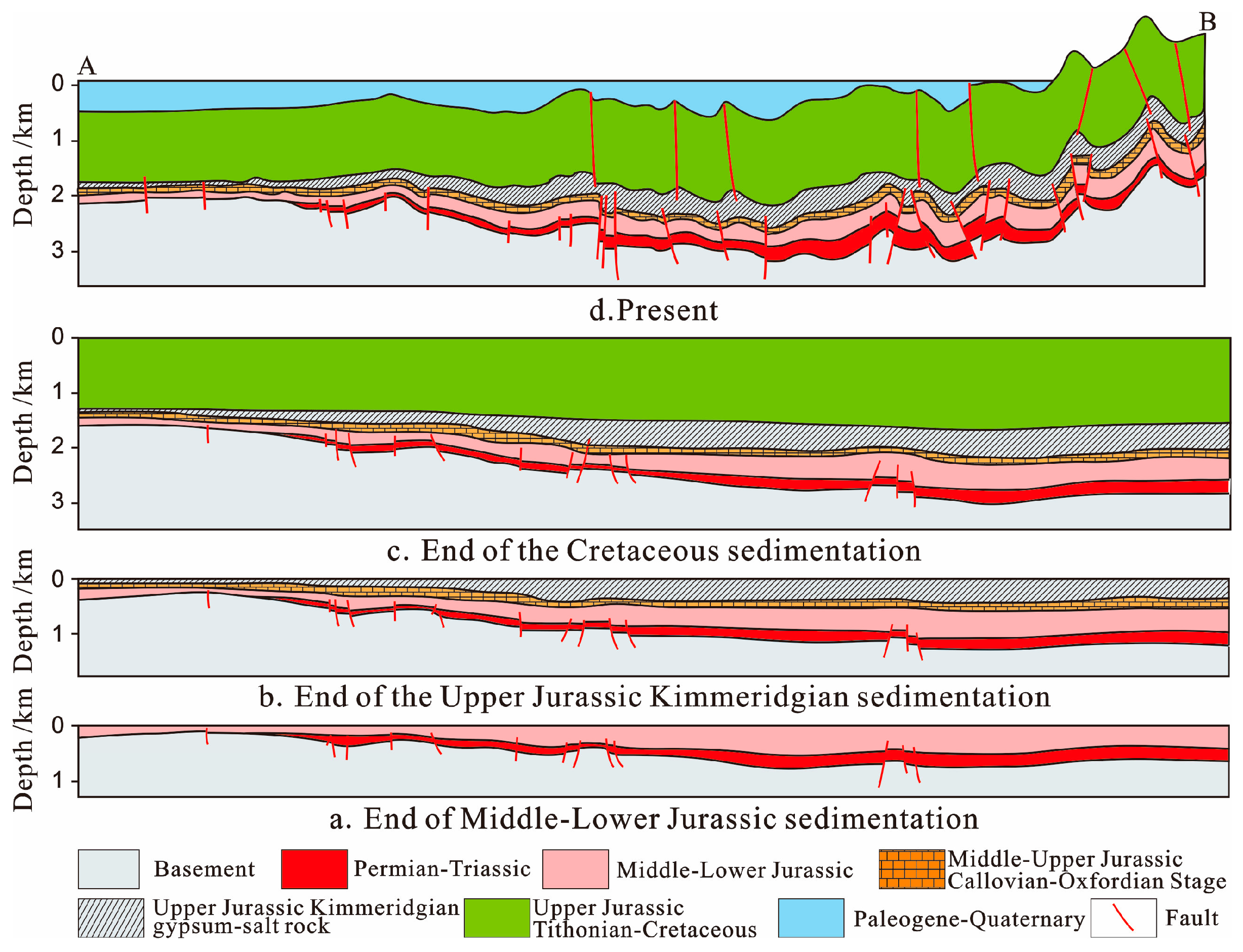



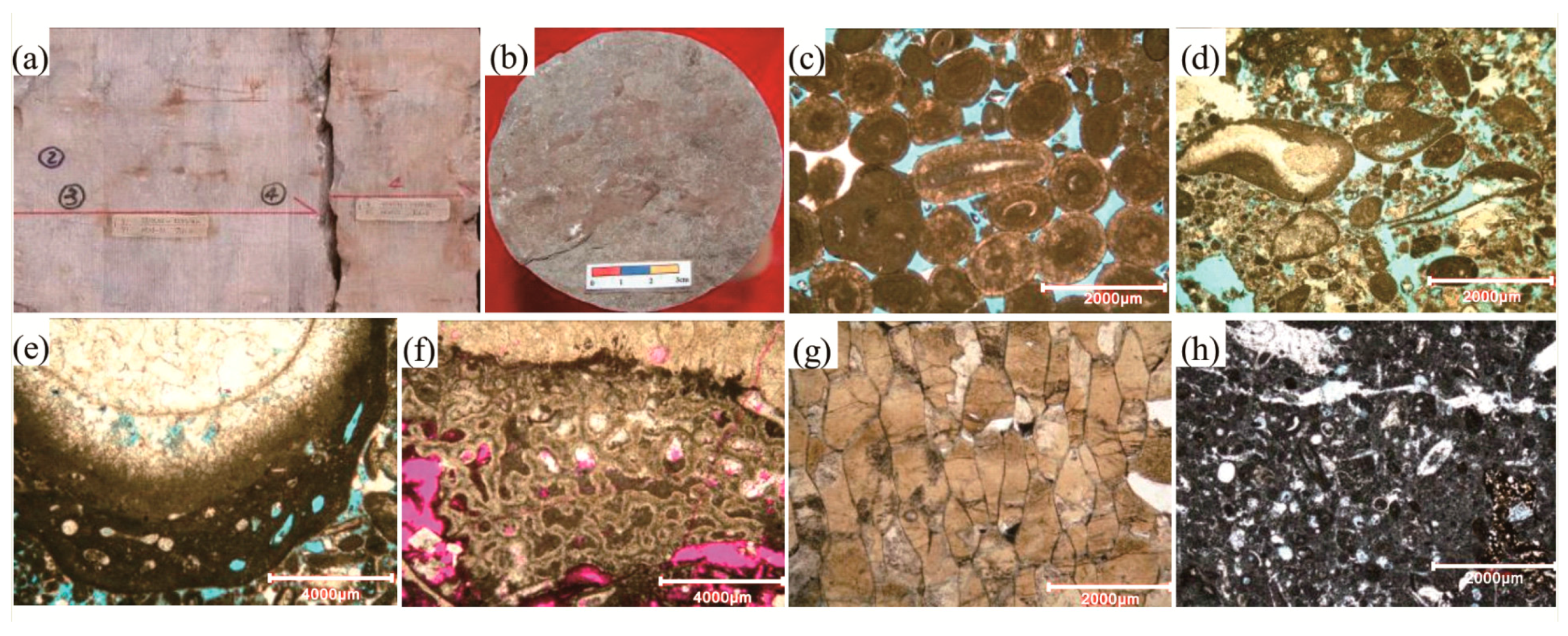

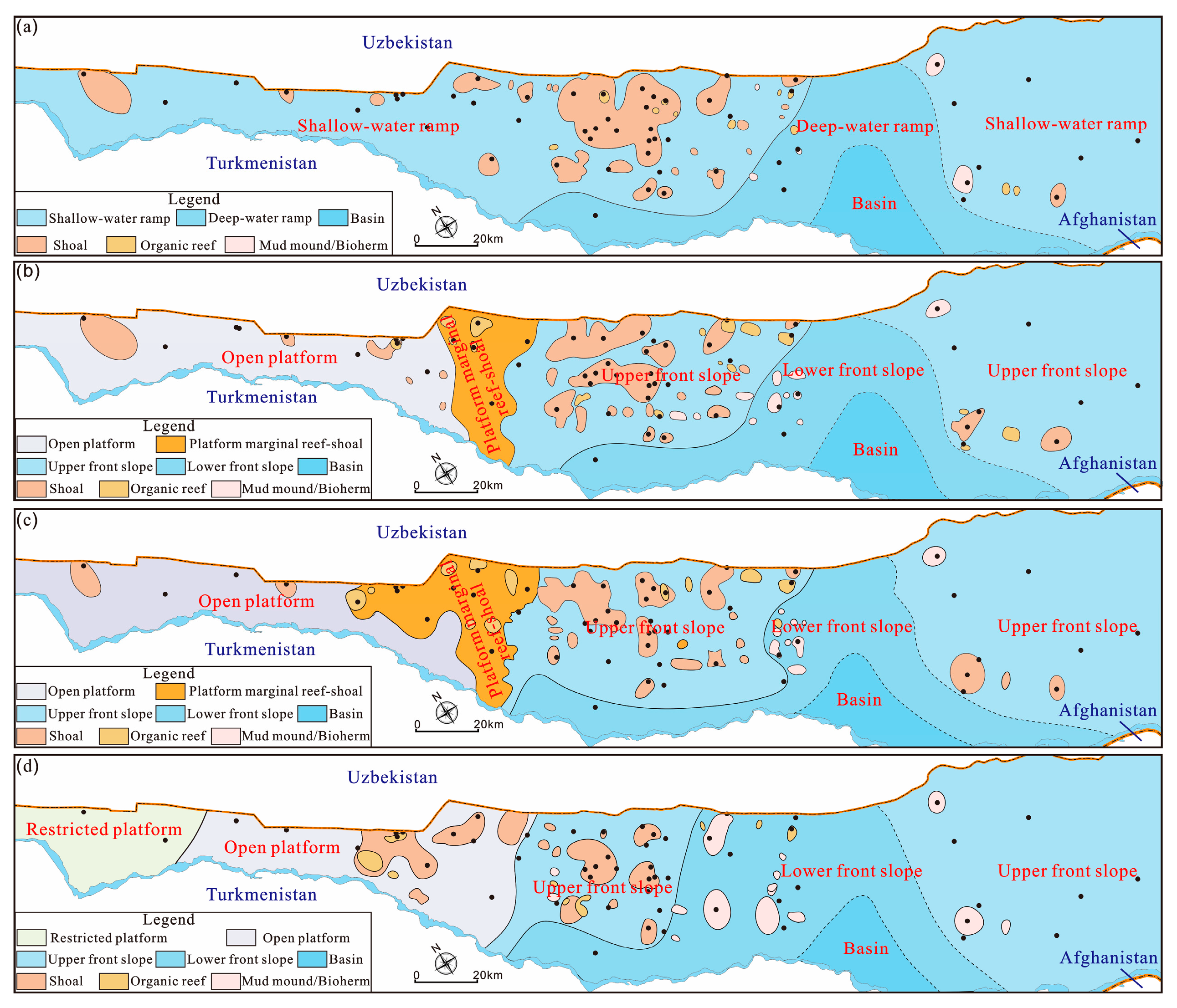



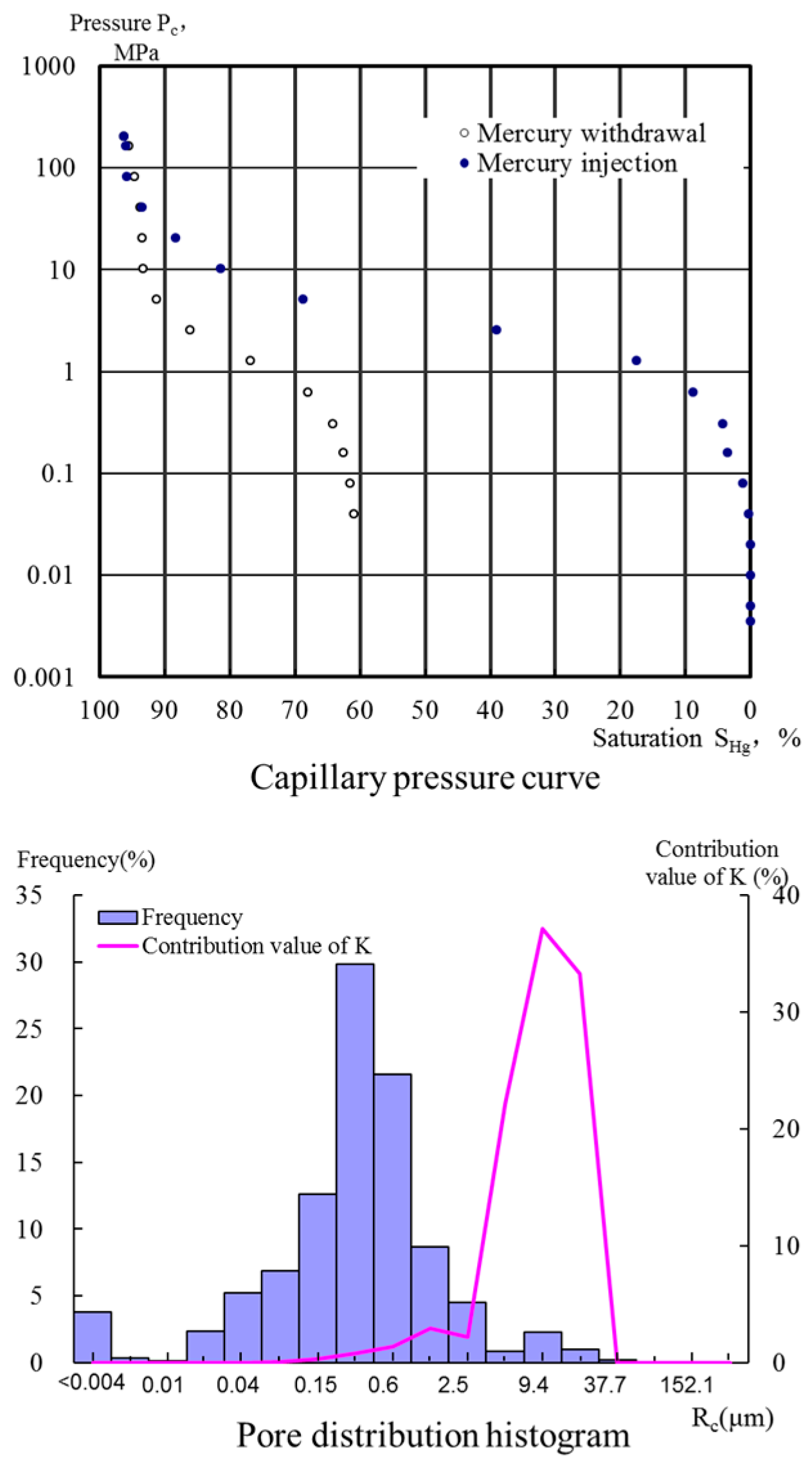
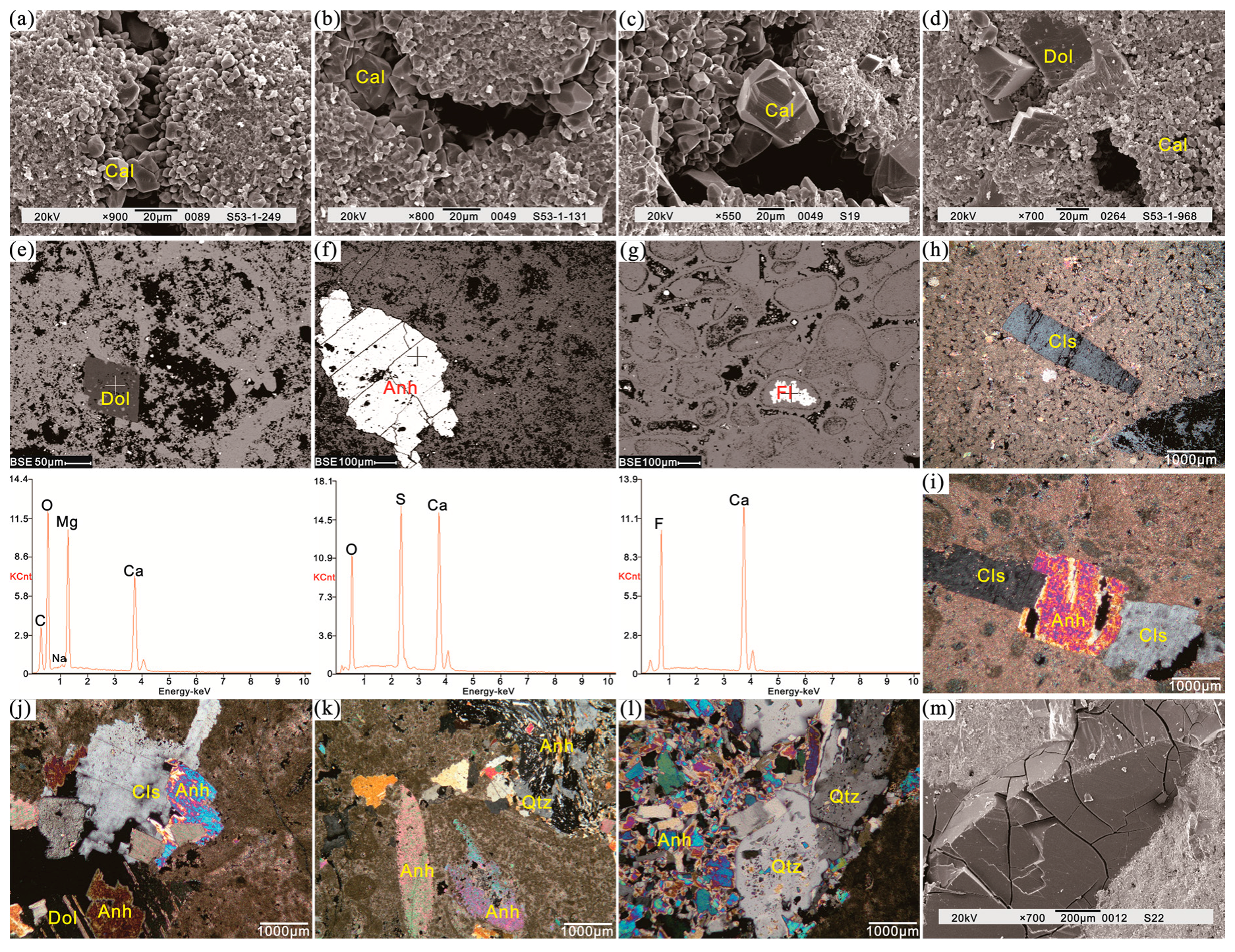
| Facies Belt | Front Gently-Inclined Ramp | ||||||
|---|---|---|---|---|---|---|---|
| Microfacies | Oolitic Shoal | Intraclastic Shoal | Bioclastic Shoal | Mound | Intershoal | Slope Mud | |
| (n = 8) | (n = 19) | (n = 14) | (n = 28) | (n = 9) | (n = 13) | ||
| Porosity (%) | Range | 5.8–14.1 | 5.9–16.2 | 6.4–19.0 | 4.8–12.2 | 2.9–10.7 | 1.5–11.6 |
| Mean | 9.4 | 10.2 | 12.2 | 9.5 | 6.3 | 5.9 | |
| Permeability (×10−3 μm2) | Range | 0.07–12.7 | 0.37–42.6 | 0.15–74.7 | <0.01–1.59 | <0.01–0.55 | <0.01–0.55 |
| Mean | 4.28 | 22.69 | 12.04 | 0.44 | 0.16 | 0.08 | |
© 2018 by the authors. Licensee MDPI, Basel, Switzerland. This article is an open access article distributed under the terms and conditions of the Creative Commons Attribution (CC BY) license (http://creativecommons.org/licenses/by/4.0/).
Share and Cite
Xu, W.; Wen, H.; Zheng, R.; Li, F.; Huo, F.; Hou, M.; Zhou, G. The Carbonate Platform Model and Reservoirs’ Origins of the Callovian-Oxfordian Stage in the Amu Darya Basin, Turkmenistan. Crystals 2018, 8, 84. https://doi.org/10.3390/cryst8020084
Xu W, Wen H, Zheng R, Li F, Huo F, Hou M, Zhou G. The Carbonate Platform Model and Reservoirs’ Origins of the Callovian-Oxfordian Stage in the Amu Darya Basin, Turkmenistan. Crystals. 2018; 8(2):84. https://doi.org/10.3390/cryst8020084
Chicago/Turabian StyleXu, Wenli, Huaguo Wen, Rongcai Zheng, Fengjie Li, Fei Huo, Mingcai Hou, and Gang Zhou. 2018. "The Carbonate Platform Model and Reservoirs’ Origins of the Callovian-Oxfordian Stage in the Amu Darya Basin, Turkmenistan" Crystals 8, no. 2: 84. https://doi.org/10.3390/cryst8020084





